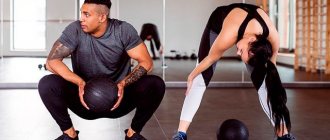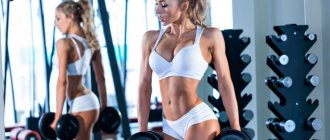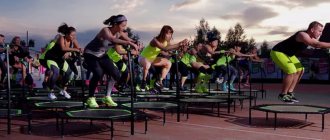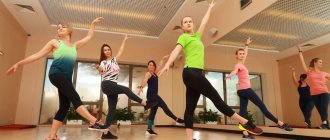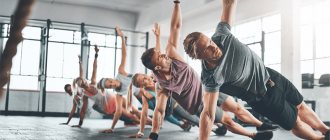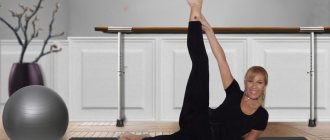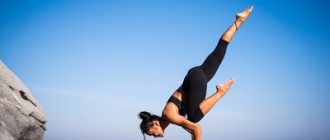Pros and cons of group fitness classes
Pros:
- They allow you to conduct training in an interesting and useful way.
- Since these are group classes, there is always an incentive to perform this or that exercise along with the advanced ones, especially when the trainer does not “get away with it.”
- Each direction is effective in its own way, one allows you to lose weight, the other strengthens muscles and ligaments, the third makes the body flexible. There is a load to suit everyone's taste.
Minuses:
- The disadvantages of group exercises are the constant pace and non-stop load, which means that the exercise cannot be completed whenever you want. Such activities require discipline, perseverance and a strong cardiovascular system.
- Not all types of exercises are aimed at the same goal, that is, not every exercise can help you lose weight or gain muscle mass, so you need to understand the specifics of the chosen direction before you start training.
Group classes
An equally popular format for training is group training. In modern fitness clubs, several separate rooms are allocated at once in order to conduct scheduled classes there. Together with the group, you can attend stretching, yoga, Pilates, dancing, aerobics and many other fitness programs.
pros
- All fitness levels are welcome, from beginner to experienced athlete, there is something for everyone in group classes.
- Total immersion: you give yourself completely to the training, as during a group class there is no one or anything to distract you.
- Increased efficiency through competition: you constantly monitor other group training participants and motivate yourself to be better than them.
- Wide range of options: you can always find a fitness program to your liking.
Photo: istockphoto.com
Minuses
- Reduced attention of the trainer: usually there are from 20 to 30 people present at the lesson, so the trainer will not physically be able to pay attention to everyone.
- Strict class schedule: you won't be able to reschedule your workout if you need to.
- High risk of injury or ineffective training: the coach does not have time to keep track of everyone.
Types of group classes in a fitness club
Aerobic directions
- Aerobics is a type of fitness in which simple dance movements are performed to rhythmic music. Aerobic movements became the basis for other areas of fitness. More about aerobics →
- Step aerobics - in the first part of the lesson, dance sequences are performed on step platforms. The second part is the strength part, in which, with the help of fitness equipment, muscle groups that have not received load are additionally worked out. More about step aerobics →
- Aqua aerobics – based on aerobic movements, as well as various exercises for all muscle groups that are performed in water. Aqua aerobics is safe compared to previous options.
- Tai-bo is an aerobic fitness movement based on boxing strikes, Muay Thai and kickboxing movements. Rhythmic exercises quickly get the body in shape and strengthen the cardiovascular system. Read more about tai bo classes →
- Bosu - aerobic movements in the form of ligaments are performed on a special rubber hemisphere on a rigid base. Thanks to the instability of the position, deep stabilizer muscles are trained.
- Cycling is a group training that takes place on cycles and simulates cycling over rough terrain and uphill. The main part of the lesson is changing the load and riding speed, the final part is strength exercises for all muscle groups. Read more about cycle training →
- Fitball is a direction in which movements and exercises are performed on a fitness ball - a fitball, which allows you to train all muscles, even the deepest ones, while holding the body on a rolling ball.
- Shaping is a trend that originated in Russia, designed for the development of the whole body, taking into account the physiology of the female body. More about shaping →
Power directions
- Functional Training - Strength training using a variety of fitness equipment allows you to train most aspects of physical performance - strength, endurance, flexibility, agility and coordination. Read more about functional training →
- CrossFit is a popular sport that is adapted to a fitness format. For CrossFit, there are specialized gyms and equipment that is non-standard for other areas of fitness. Read more about CrossFit →
- Boxing is a workout that is performed in an aerobic style using special boxing equipment in the form of a pear. The main movements are striking the punching bag with your hands and feet.
- Body pump is a strength training aimed at strengthening all the muscles of the body using a fitness barbell. The patented methodology has many training programs that are constantly being improved and changed. Read more about Body pump training →
- Body sculpt is a complex of areas that includes strength training that develops different parts of the body. For example, Upper body is aimed at developing the shoulder girdle, Butt+fleks – gluteal muscles and hips. Read more about Body scalp →
- Martial arts - various areas in a fitness format, which include elements of Thai boxing, Ku-Do, karate, kickboxing, taekwondo. Read more about the fit-bo direction →
Intelligent body
- Oxysize is a “Body and mind” direction in which static exercises are performed with a special breathing technique that promotes fat burning. Read more about oxysize →
- Yoga , or more precisely Ha-Tha yoga, is a set of asanas aimed at developing flexibility of the whole body, joint mobility, strengthening muscles and ligaments. It also includes breathing exercises - pranayama.
- Pilates is a healing practice for all ages, regardless of gender. The direction has a positive effect on the body as a whole, helping to improve the functions of the musculoskeletal system. Read more about Pilates →
- Port de Bras is a dance style that incorporates elements of choreography performed to calm music in the style of Pilates. Classes work deep muscles, make the body more flexible, and movements smooth and graceful. Read more about port de bras →
- Stretching - includes muscle stretching exercises performed both statically and dynamically. Stretching helps relax tight muscles, increases the flexibility of ligaments and fibers, improves blood circulation and strengthens muscles. More about stretching →
- Callanetics is currently not so popular, but is still found in fitness clubs and is a set of exercises performed in static tension. More about callanetics →
- Aeroyoga – classes take place in special hammocks, allowing you to completely relax your body and perform exercises in zero gravity.
- Qigong is a gymnastics based on Taoist practices, performed for health purposes.
Types of training
Aerobic
This direction develops the body’s ability to absorb oxygen as much as possible. During the classes, the cardio-respiratory system is activated, tissue metabolism is enhanced, calories are burned, weight is lost and the figure is sculpted. Aerobic group fitness training differs in the way the programs are structured and the ultimate goals.
- Dance (dance aerobics). This is a set of exercises for large muscle groups, mainly the lower body. This type includes belly dancing (belly dancing), Latin, rock and roll, funk, strip dancing, city jam, jazz aerobics, etc.
- Step. Step aerobics is a cardio program with the main load on the leg and gluteal muscles. The training takes place to rhythmic music, on a height-adjustable platform step (the higher, the more difficult). Recommended for developing joints, increasing endurance, preventing diseases associated with physical inactivity, and improving the functioning of the vestibular apparatus. Main varieties: Step-basics (basic skills), Step-1 (medium level of difficulty), Step-comb (combination with dancing), Step interval (using weights), Double step (classes on 2 step platforms).
- Fitball aerobics. Exercises with a large Swiss ball (fitball) involve a large range of motion and require constant muscle tension. The peculiarity of the training is the absence of excessive stress on the legs. It can be used for varicose veins, joint problems and excess weight (after consultation with a doctor).
- Cyclic aerobics. Includes programs that use cyclic activities (cycling, rowing, running). Trainings take place to music, on machines that force all parts of the body to work.
Power
Strength types of group fitness training are designed to build muscle mass and “build” relief. The programs combine exercises that combine aerobic and weight training. Weights, dumbbells, barbells, gymnastic sticks, balls, expanders, etc. are used as weights. The most popular strength exercises:
- Super-buttocks (training on machines to strengthen the upper body);
- ABL (working the legs and shoulder girdle);
- MONSTER TRAINING (pumping all muscle groups);
- ABC (strengthening the back and abdominals);
- Press + Buttocks (training the buttocks and abdominal muscles);
- BODY SKULPT (creating sculpted muscle mass, modeling the lower body).
Fitness based on oriental practices
Programs with elements of martial arts improve not only external data. They strengthen fortitude and provide self-defense skills. High-intensity aerobic exercise develops endurance, increases strength, and increases energy levels. The popularity rating includes training with elements of karate, Afro-Brazilian wrestling, kickboxing, judo, kung fu, taekwando, etc.
Low impact programs
Such group fitness classes are gentle. They are suitable for both beginners and adepts who are forced to avoid intense exercise. The list of low-impact wellness programs includes:
- Pilates (a complex for strengthening the back, abdomen and buttocks, stabilizing the spine and improving the functioning of the cardiovascular system);
- Callanetics (a direction based on static exercises and basic yoga asanas). Promotes the development of deep muscle groups that do not “work” during classical training;
- Muscular and joint gymnastics (a program aimed at developing flexibility and improving joint mobility). Suitable for all age categories, enhances adaptive capabilities, prevents the onset and recurrence of the disease;
- Yoga (a system of dynamic practices including meditation, autogenic and breathing techniques, flexibility and relaxation exercises). The most popular areas: hatha yoga, anti-gravity (yoga in hammocks), fit, kundalini, yin yoga.
Water training
Aquatic fitness is a solution for those who like to exercise in the pool and for those for whom “land” training is contraindicated. Popular varieties:
- Water aerobics (includes dancing, running in water, movements with elements of martial arts, classes with water sports equipment);
- Aquapilates (static exercises for various muscle groups in aquaboots and gloves);
- Aquaflat (trainings on fixed plastic rafts);
- Aquastep (classes on a stepper platform);
- Aquabiking (exercises on water simulators).
Regular training in water helps improve posture and strengthen joints and muscles, lose weight, reduce cellulite and prevent diseases of the musculoskeletal system.
Combined trainings
These group mix programs combine high-intensity cardio training and weight training. They help you lose excess weight faster, at the same time tighten your skin and get beautiful muscle relief. By sequentially alternating aerobic and anaerobic exercise, more calories are burned in a shorter period of time.
Kinds
You may be interested in: How to build up the thickness of your back: exercises and recommendations
The number of types of such training is increasing day by day. This area is popular, and trainers continue to invent new variations. Thus, step aerobics and fitness aerobics are distinguished - these are the most popular cardio workouts. Stretching is done in Pilates and yoga. Body Sculpt, ABT, Upper Body are aimed at building muscles.
Mixed workouts
These classes combine cardiovascular training, full-body muscle work with additional equipment, and increased calorie burn. One of the most popular types of such lessons is “functional training,” when exercises are performed in which a large number of muscles are simultaneously involved in the work.
In other words, you work not only the main muscle that the exercise is aimed at, but also the so-called stabilizer muscles, which overall increases the effectiveness of the workout. Such classes include: circuit training, interval training, as well as TRX loops, and for the most advanced, cross-fit, which is popular all over the world.
Strength lessons
Aimed at developing muscles, increasing their size, as well as training endurance and strength, lessons are held both with special equipment (barbells, dumbbells, twine) and with your own body weight. You need to understand that during strength lessons the technique of performing each exercise is very important, because additional weight can cause serious injury if the movement is careless. Therefore, if you are a beginner, then choose lessons for beginners.
It is also important to understand that strength classes do not completely replace training directly in the gym. In group lessons, as a rule, they work with light weights but frequent repetitions (20 or more in one approach), and this mode of work will not lead to a serious increase in muscle mass. Which, in fact, is only good for girls who don’t need large muscle mass. But for men who would like to see more muscles on themselves, this lesson is not suitable.
Photo: depositphotos/lunamarina
Is it possible to work out in the gym on your own?
There is no correct answer to this question. After all, if you have been working with a personal trainer for a long time or attend weekly group classes and have learned almost the entire range of proposed exercises, you can safely try to switch to independent training. But if you are a beginner and are unfamiliar with most of the machines in the gym, then practicing on your own can be dangerous.
Andrey:
First of all, independent training carries the risk of injury. Incorrect technique, especially in exercises with free weights (dumbbells, barbells), can lead to unpleasant consequences - pinching, sprains. Working in simulators partially removes these risks. The second point is the danger... of not getting the desired result. Incorrectly calculated loads or the number of approaches/repetitions can slow down progress, or even completely eliminate it. That is, you regularly go to the gym, move from one machine to another, push/pull/lift something, but this does not affect your appearance in any way. And even the working weights are always the same. But I’m not at all trying to convince everyone that without a personal trainer, on your own, there’s no point in going to the gym. Of course this is not true. This is not some kind of super-wisdom that is available only to a select few. Everything is quite simple, but you need to prepare to understand the basic principles a little. Watch videos, read a couple of articles. In general, take your time. Or money to pay for the services of a personal trainer. Depending on what you have more of.
Photo: istockphoto.com
